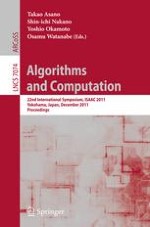This book constitutes the refereed proceedings of the 22nd International Symposium on Algorithms and Computation, ISAAC 2011, held in Yokohama, Japan in December 2011. The 76 revised full papers presented together with two invited talks were carefully reviewed and selected from 187 submissions for inclusion in the book. This volume contains topics such as approximation algorithms; computational geometry; computational biology; computational complexity; data structures; distributed systems; graph algorithms; graph drawing and information visualization; optimization; online and streaming algorithms; parallel and external memory algorithms; parameterized algorithms; game theory and internet algorithms; randomized algorithms; and string algorithms.
